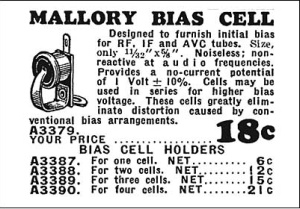I am wondering, in the pursuit of low noise, would it be possible to use the leakage current of something like a 1n4148 to bias up the grid leak? and eould this offer noise benefits over-say, a run of the mill 1/4W metal film?
That diode wouldn't give a consistent grid voltage from leakage, which also varies with temperature.
Last edited:
I think your right, i couldn't get the answer myself from some of the data sheets i checked out on switching diodes.
Perhaps useful in some limited circumstances.. The drawback you get is 3-4pF of unlinear capacitance at your grid. But say you split up the cathode resistor into a capacitor bypassed part and a non bypassed part to ground. I think you could bootstrap some of that unlinear capacitance.
Perhaps useful in some limited circumstances.. The drawback you get is 3-4pF of unlinear capacitance at your grid. But say you split up the cathode resistor into a capacitor bypassed part and a non bypassed part to ground. I think you could bootstrap some of that unlinear capacitance.
If you were after noise reduction, then perhaps revert to a button battery to obtain bias when cathode is grounded (to remove the cathode from being a noise/hum contributor). Button batteries have come a long way since 1930's, although price has gone up.


I know of battery bias. but im all about the unusual.
You could use a small 1F supercapacitor for that purpose and just charge it of the HT trough a couple Megohm.
I figured that for some SQ tubes with very low grid current. E80F (Electrometer tube) for example. you could bias up the grid with a diode with only 100nA or so current.
my aim was to use higher value anode resistors for tubes like the EF86 so you can get good gain out of them.
That. and to post something more unusual.
You could use a small 1F supercapacitor for that purpose and just charge it of the HT trough a couple Megohm.
I figured that for some SQ tubes with very low grid current. E80F (Electrometer tube) for example. you could bias up the grid with a diode with only 100nA or so current.
my aim was to use higher value anode resistors for tubes like the EF86 so you can get good gain out of them.
That. and to post something more unusual.
One hassle with managing very low grid node current in the nA range is the input signal coupling cap leakage and what may be providing the signal.
Down at the nA level, a diode would I think have a resistive characteristic anyway (as well as being temperature dependent), so were you hoping for the semiconductor junction to have lower noise?
Bootstrapping the anode load of an input stage pentode is I recall the common vintage method for substantially increasing stage gain, having tried it with a Jeffery circuit (from 1947).
Down at the nA level, a diode would I think have a resistive characteristic anyway (as well as being temperature dependent), so were you hoping for the semiconductor junction to have lower noise?
Bootstrapping the anode load of an input stage pentode is I recall the common vintage method for substantially increasing stage gain, having tried it with a Jeffery circuit (from 1947).
v4lve lover,
I think most good resistors, at something like 25 Degrees C, that do not have DC passing through them, have a noise level of -174dBm/Hz.
What is the low level signal that you are using to drive the input stage that is using grid leak bias?
Just for an example: A low level moving coil phono cartridge?
Note: The lower a passive signal source impedance is, the lower the V/root Hertz is.
Such as a low output moving coil phono cartridge (very low DCR).
If that phono cartridge is supposed to be loaded with 100 Ohms, the V/root Hertz of the resistor is extremely low.
How much excess gain in the amplifier do you have, that would amplify -174 dBm/Hz in the grid leak resistor so that you can hear it?
And what is the required loading on the signal source?
I am just trying to understand your application.
I think most good resistors, at something like 25 Degrees C, that do not have DC passing through them, have a noise level of -174dBm/Hz.
What is the low level signal that you are using to drive the input stage that is using grid leak bias?
Just for an example: A low level moving coil phono cartridge?
Note: The lower a passive signal source impedance is, the lower the V/root Hertz is.
Such as a low output moving coil phono cartridge (very low DCR).
If that phono cartridge is supposed to be loaded with 100 Ohms, the V/root Hertz of the resistor is extremely low.
How much excess gain in the amplifier do you have, that would amplify -174 dBm/Hz in the grid leak resistor so that you can hear it?
And what is the required loading on the signal source?
I am just trying to understand your application.
Last edited:
Replacement of a 50MEG resistor in a tube microphone. Ive heard of diodes being used to replace expensive high value resistors. Input is likely going to be a jfet/E83F cascode. Its just an idea to keep the gray mass going
- Home
- Amplifiers
- Tubes / Valves
- Diode leakage as a grid leak